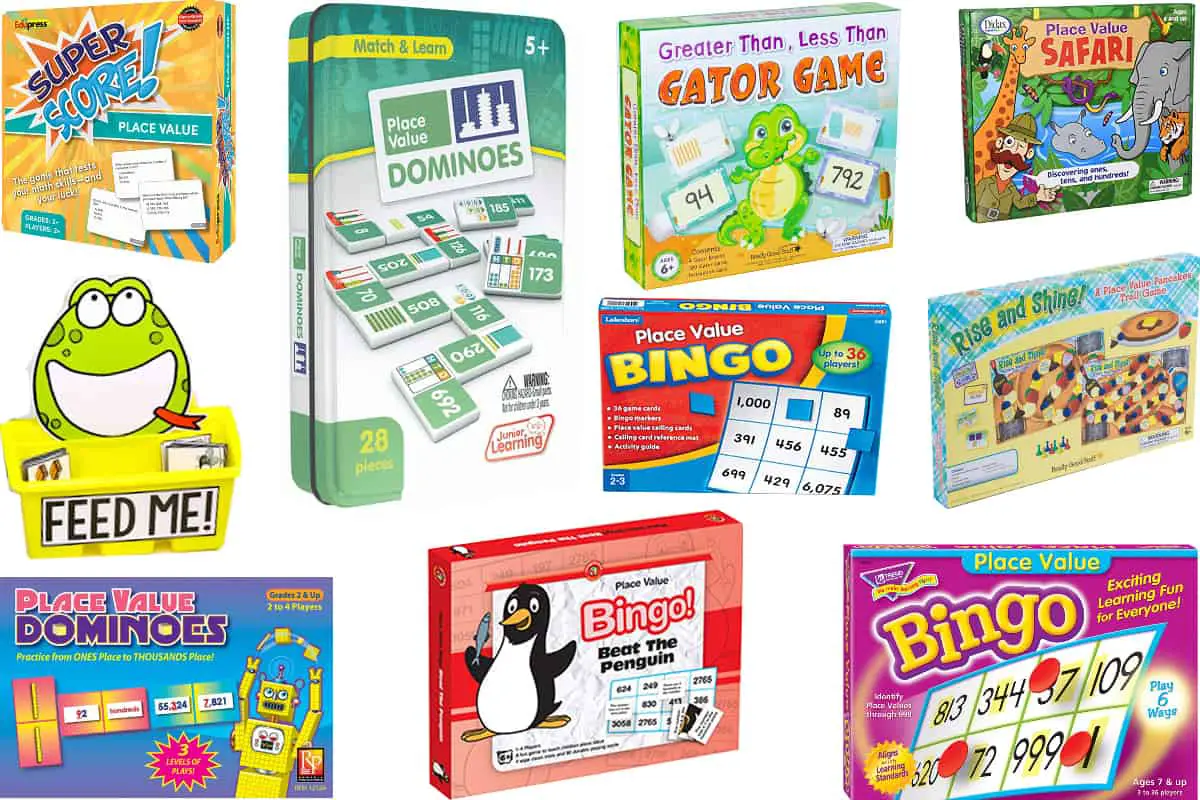This post contains affiliate links.
As place value is crucial but fairly dull, games are perfectly suited to help understand this notion. Here are 12 board games to make studying place value much more entertaining.
These twelve place value board games (including three bingo and two domino games) are for children between 5 and 11-year-old. Each has its own focus and aims to improve on at least one core standard skill. However, when it comes to generally improving place value skills, I highly recommend Dino Math Tracks, Place Value Mystery House, and Place Value Safari. All three combine core foundational skills with an entertaining activity that will help to make the topic more accessible to younger learners.
Recommended Place Value Board Games Comparison Table
These nine place value board games (including two bingo games) are for children between 5 and 11-year-old.
| Game | Grade | Players | For | <$ | Focus | Rating |
| Dino Math Tracks | K-4 | 2-4 | Home, School | £££ | Understand, Operations | ★★★★★ |
| Feed Me – Place Value Chips | 1-2 | 1+ | Home, School | $$ | Understand | ★★★☆☆ |
| Gator Game | 1+ | 1-8 | Home, School | $$$ | Understand, Compare | ★★★☆☆ |
| Place Value Mystery House | 2-3 | 2-4 | Home, School | $$$ | Understand, Operations | ★★★★☆ |
| Place Value Bingo (Lakeshore) | 2-3 | <36 | School | $$ | Understand, Operations | ★★★★☆ |
| Place Value Bingo (TREND) | 2+ | 3-36 | School | $$ | Understand | ★★★☆☆ |
| Place Value Grab & Play | 1-2 | 2-4 | Home | $$$ | Understand | ★★★☆☆ |
| Roll & Solve Place Value Game | 2 | 2-4 | Home | $$$ | Understand | ★★★☆☆ |
| Beat the Penguin | 1-3 | 1-3 | School, Home | $$$ | Understand | ★★★★☆ |
| Place Value Dominoes (Didax) | 1-2 | 1-4 | Home, School | $$ | Understand | ★★★☆☆ |
| Place Value Dominoes (Remedia) | 1-2 | 2-4 | School | $$ | Understand | ★★★☆☆ |
| Super Score – Place Value | 2-3 | 2+ | Home, School | $$ | Understand, Operations, Rounding | ★★★☆☆ |
| Place Value Safari | 2-5 | 1-4 | Home, School | $$$ | Understand, Operations | ★★★★☆ |
| Rise and Shine | 4-5 | 2-8 | Home, School | $$$ | Understand+, Operations | ★★★☆☆ |
Where the codes denote the following core skills:
- Understand: Understanding place value, counting, reading, and writing numbers up to 1000 by using 1s, 10s, and 100s
- Understand+: Same but up to a million
- Compare: Comparing three-digit numbers
- Operations: Add, subtract, and perform multi-digit arithmetic
- Round: Rounding whole, multi-digit numbers
Place Value Board Games
Dino Math Tracks Game (Learning Resources)
★★★★★

Players 2-4 | Age 5-10 | For Classrooms & Families| Price: £££
Dino Math contains a game board, 16 dinosaurs, 72 cards and 5 leveled dice with 3 levels of play.
contains a game board, 16 dinosaurs, 72 cards and 5 leveled dice with 3 levels of play.
Players race their dinosaurs to the finish line, employing their understanding of singles, tens, hundreds, and thousands to navigate the board. The game helps to build on the following skills:
The board is made of four tracks that represent color-coded ones, tens, hundreds, and thousands. Players maneuver their 4 color-coded plastic dinos along the tracks and solve problems that reinforce their knowledge of place value.
Players place their dinosaurs at the start of each lane, matching the color of the dinosaur to the color of the track.
- a mammoth loses its pants, runs back fifteen steps and sprints forward twenty-five steps. Calculate the answer and move your herd accordingly”).
I love the original way to keep the little ones entertained. It does a fantastic job of introducing the basics of place value. It is also easily adapted to the player’s skill level, by restricting to just one or two tracks with ones and tens.
For more information, here’s a link to the official game guide . In addition to this, you can see a video demonstration of the game here:
. In addition to this, you can see a video demonstration of the game here:
Gator Game – Greater Than, Less Than (Really Good Stuff)
★★★☆☆
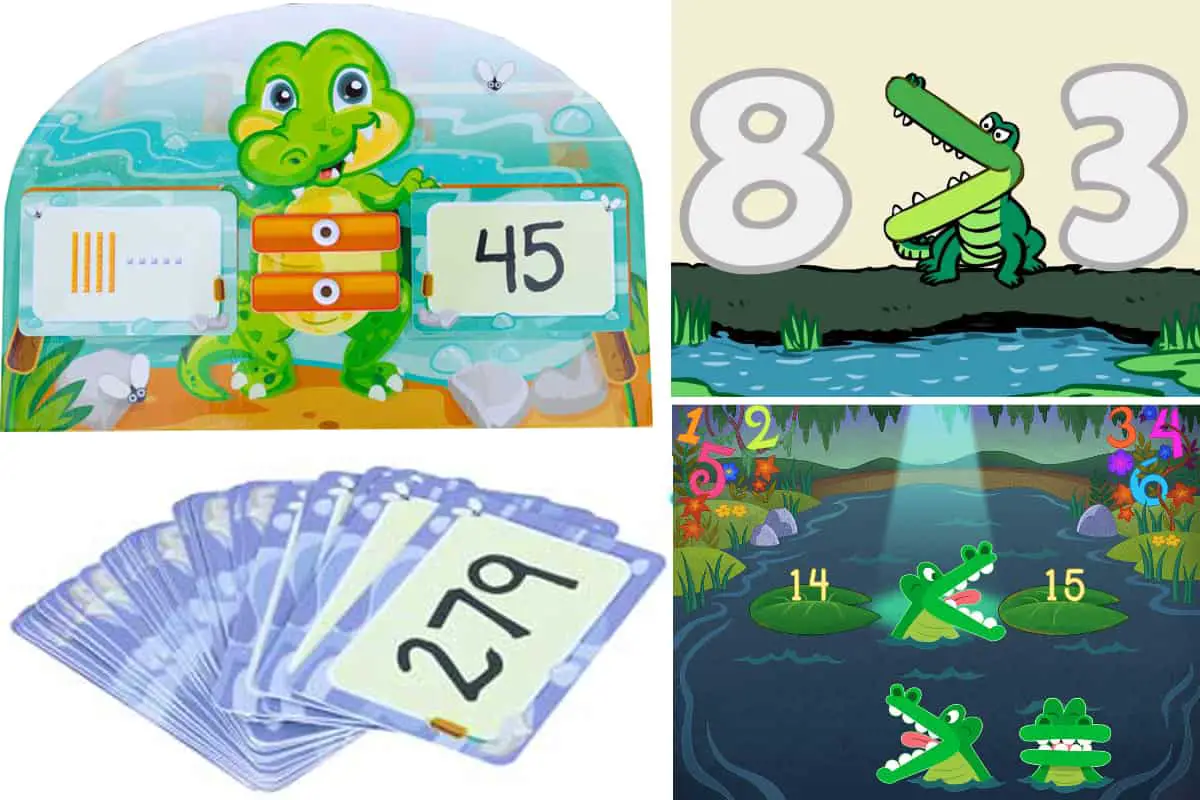
Players: 1-8 |Ages: 6+ | For Families & Classrooms | Price $$$
In Greater Than, Less Than Gator Game , players are asked to compare two numbers and determine the difference in value. The game includes:
, players are asked to compare two numbers and determine the difference in value. The game includes:
- 4 gator boards
- 4 sets of 30 laminated number cards (120 cards total), color-coded by level (2 or 3-digit numbers). For each level the number is either written with digits or illustrated with base-10 blocks.
- 1 instruction card
The game works like a game of war:
- Players compare the numbers on two cards and decide if they are equal to, greater than, or less than the other. They use the <, = and > symbols on the board to represent their findings.
- The higher value card wins, and the player gets to keep both cards. If the values are equal, each player keeps their own card.
- Cards are placed in separate piles to keep score
Players can practice alone or play in groups of two
Difficulty can be adjusted, using two- or three-digit numbers, and using one or both representations of numbers.
I like having numeric and visual representations of the numbers and actually using them in the game mechanism. This helps children to identify the real meaning of place value numbering.
Place Value Mystery House Game (Lakeshore Learning)
★★★★☆
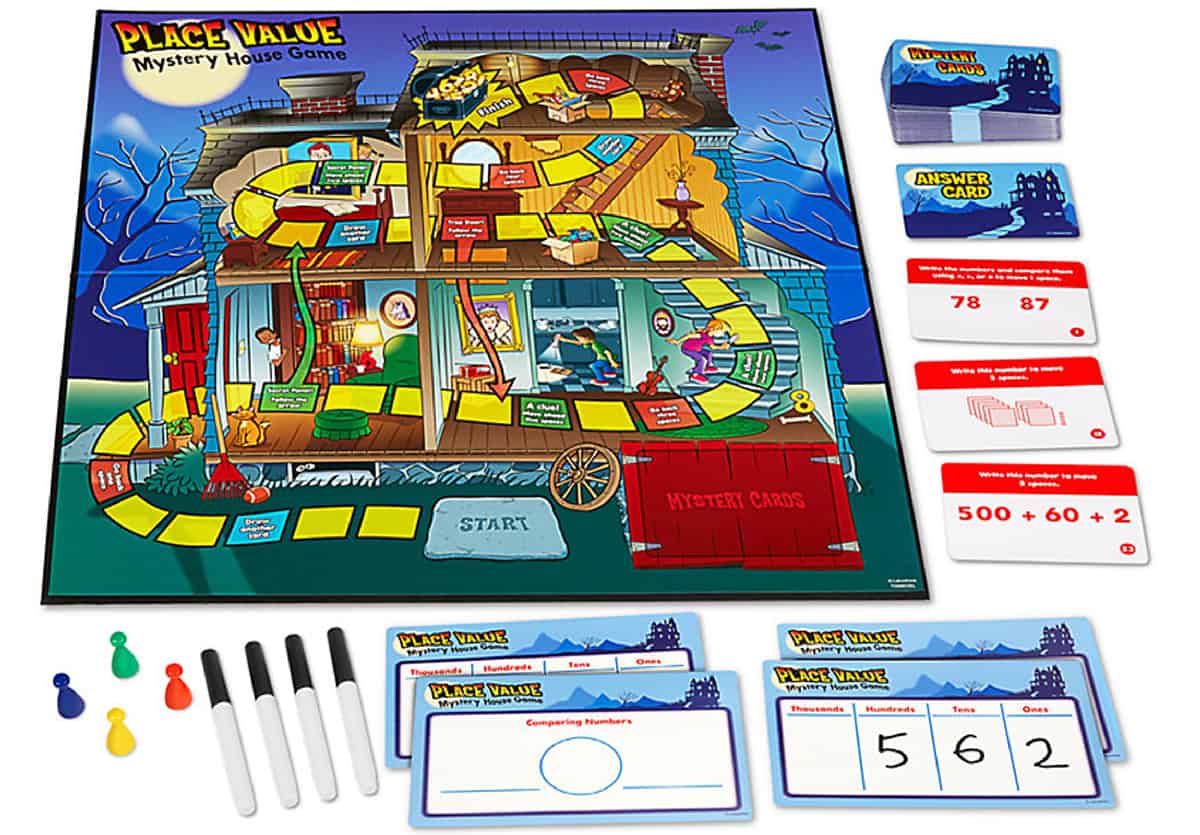
Players: 2-4 | Ages: 7-8 | For Families & Classrooms | Price: $$$
In Place Value Mystery House Game , players visit a haunted house and solve place value problems to move along the board.
, players visit a haunted house and solve place value problems to move along the board.
It contains:
- A game board
- 50 Mystery cards
- An answer card
- 4 write & wipe place value cards
- 4 dry-erase markers
- 4 pawns
Players take turns drawing a mystery card and writing the solution of its place value problem on their erasable place value card. If the answer is correct, the player moves their pawn forward. The first player to reach the treasure chest filled with gold numbers is the winner.
I like that players write their answers down, reinforcing their understanding of thousands, hundreds, tens, and singles. Also, the mysteries involve not only understanding place value but also adding and subtracting numbers.
Place Value Safari: Discovering Ones, Tens, and Hundreds (Didax)
★★★☆☆
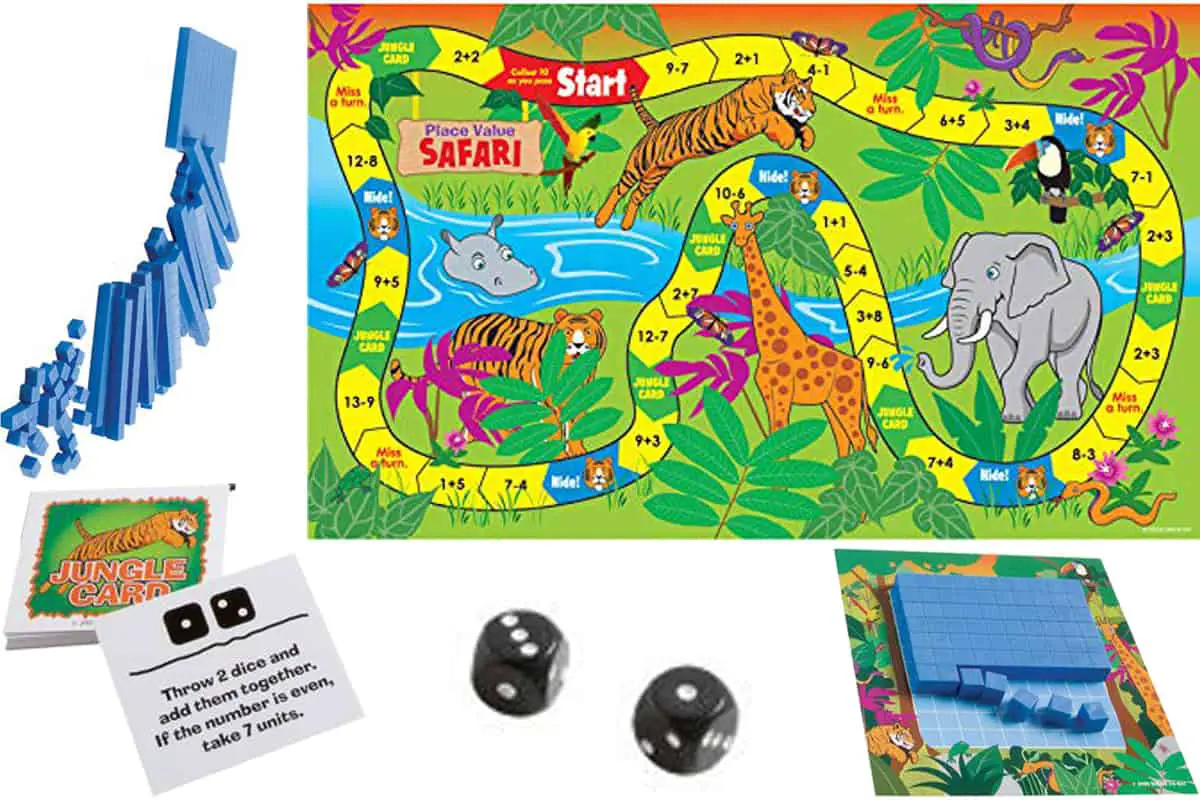
Players: 1-4| Ages: 7-11 | For Classrooms & Families | Price: $$$
In Place value Safari , players perform additions, subtractions, and other basic math tasks to move across the board and escape from the tiger.
, players perform additions, subtractions, and other basic math tasks to move across the board and escape from the tiger.
This game contains:
- A Jungle Playing Board
- 1 flat square representing 100, 40 Rods representing tens, 40 cubes representing units
- 4 Safari Boards
- 15 Jungle Cards
- 4 Counters Instructions
- 2 Dice
Players need to solve problems presented by the jungle cards to gather points to fill up their Safari Boards. Points are awarded in single units and rods of ten. The first player to fill the one hundred flats on their Safari Board wins.
I like the use of units, rods, and flats combined with a nice safari theme. All the basics representations are used (dices, cubes and rods).
I don’t like that place value is not really taught though despite the game’s name. because of this I give only three stars to “Place Value Safari”, which is a good game overall.
Rise and Shine! (Really Good Stuff)
★★★☆☆

Players: 2-8| Ages: 9-11 | For Classrooms & Families | Price: $$$
Rise and Shine! A place Value Pancakes Trail Game is illustrated with pancakes, chocolate chips and bananas. Players work with harder place value problems than on other games on this post.
is illustrated with pancakes, chocolate chips and bananas. Players work with harder place value problems than on other games on this post.
It contains:
- 2 double-sided game boards
- 2 card decks of 70 cards (140 cards total)
- 1 instruction card
- 2 answer key cards
- 8 pawns
Two modes of play enable players to either work with values up to a thousand, or up to a million.
The game helps understanding place value up to a million and performing multi-digit arithmetic (adding and subtracting).
One deck is for place value problems up to a thousand, while the other is for problems up to a million. This makes the game adjustable to the player’s age and skill level.
Players take turns drawing cards and answering the place value problems presented. They ask the player to identify place value (for example How many hundred thousands are in this number: 8,119,671) or to perform additions using singles, tens, and thousands.
I like the fact that answer sheets are provided which makes players autonomous, and the possibility to adjust the difficulty.
Super Score – Place Value (Edupress)
★★★☆☆
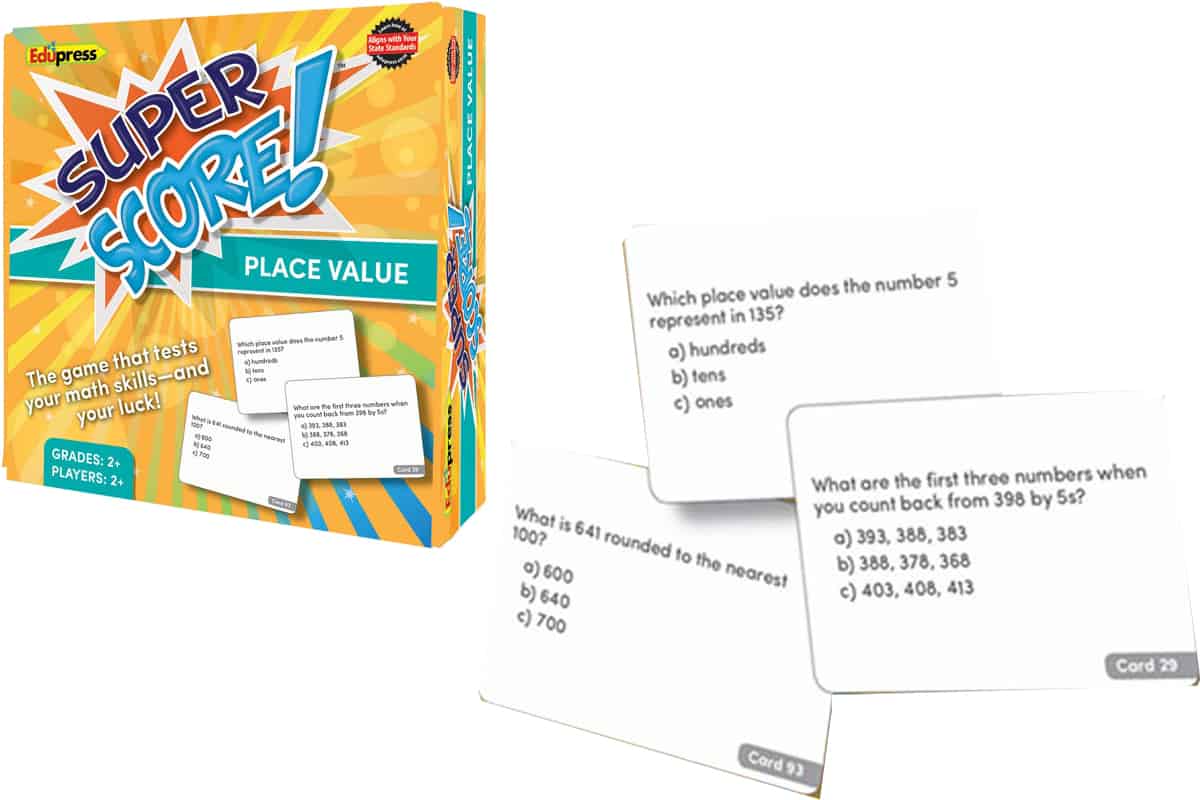
Players: 2+ | Ages: 7-9 | For School & Home | Price: $$
In Super Score – Place Value , players solve place value problems to collect points. Aside from reinforcing the player’s understanding of place value, this game also makes use place value understanding to add and subtract as well as round whole, multi-digit numbers.
, players solve place value problems to collect points. Aside from reinforcing the player’s understanding of place value, this game also makes use place value understanding to add and subtract as well as round whole, multi-digit numbers.
Students take turns drawing cards and solving the place value problems presented on them to collect points. If lucky, you may even draw a Score Card. The game ends once a player has collected four Score Cards. The player with the highest score wins.
Cards are formatted so that students pick their answer from one of three potential solutions, for example:
What is 641 rounded to the nearest 100?
- 600
- 640
- 700
The game mechanics are not fun but the questions are relevant and do introduce rounding, which is an important notion.
Place Value Grab & Play (Lakeshore Learning)
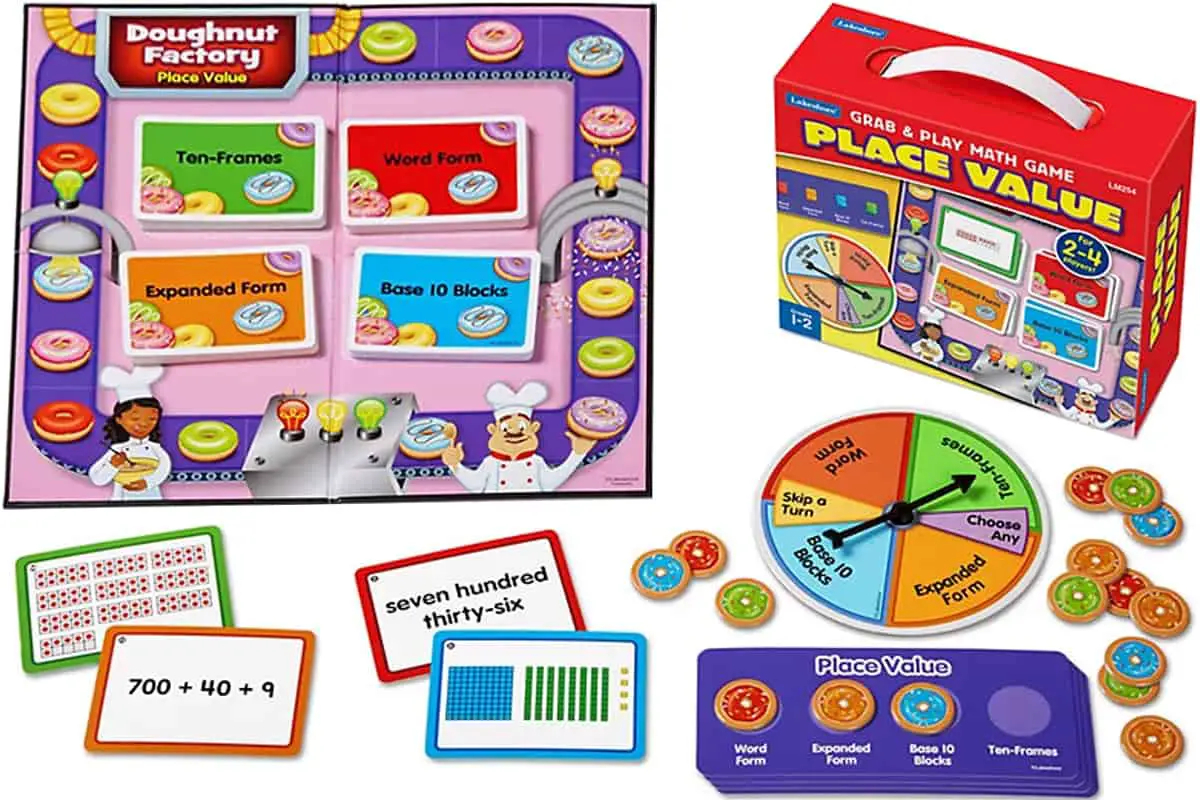
★★★☆☆
Players 2-4 | Age 6-7 | For Families | Price: $$$
Place Value Grab & Play includes a spinner, 48 problem cards, 4 tracking mats, 16 game tokens, an answer card, and a game board that measures 12″ x 12″.
includes a spinner, 48 problem cards, 4 tracking mats, 16 game tokens, an answer card, and a game board that measures 12″ x 12″.
This game offers challenges in:
- Identifying the number position (location within two digits and three digits)
- Reading numbers to 1000 in number, word, and expanded form
The main objective of this game is to be the first player to fill the tracking mat with a token that represents the following categories:
- Word form
- Ten frames (rectangle separated in two rows with ten equal spaces)
- Base 10 Blocks (blocks that represent ones, tens, hundreds)
- Expanded form (way of writing numbers according to value separated by plus sign)
Each player gains a token by identifying correctly the number based on the category on the spinner.
This game is appealing to 6–7-year-old children because the gameboard has colorful illustrations and the tokens are shaped like donuts.
I like the idea of challenging children to express numbers in four different ways. It is helpful in comparing numbers and digits visually.
Also, it can be played by 2-4 players cooperatively. However, if played longer than 15 minutes, the game becomes boring because the gameplay is repetitive.
I recommend playing this game by category first like flashcards so that beginners may focus on each concept.
Roll & Solve Place Value Game (Lakeshore Learning)

★★★☆☆
Players 2-4 | Age 7-8 | For Families | Price: $$$
Roll & Solve Place Value Game is good for studying place values up to three digits.
is good for studying place values up to three digits.
It includes:
- 8 double-sided write and wipe game cards
- 4 write and wipe markers
- 6 dice
- a dice cup
- a guide
To play this game with 2-4 players,
- Give each player two game cards to solve.
- Each card contains six items to answer.
- The goal of the game is to complete the game card by rolling the dice to get the correct ones, tens and hundreds.
- Write the missing numbers on the mat.
- This game will take 15-20 minutes to finish.
I dislike the idea of rolling the dice because
- children can directly answer the game cards without it (which is better)
- The answers are written at the back (cheating may happen and learning will be sacrificed because of competition)
- Waiting for the correct number to show up on the dice makes the game boring (I suggest asking children to say aloud the number they need before rolling the dice to instill the place value they are looking for)
Despite these, I still recommend this game for 7–8-year-old children because it offers practice in identifying and writing place values in expanded form.
Place Value Bingo Games
Place Value Bingo (Lakeshore Learning)
★★★★☆
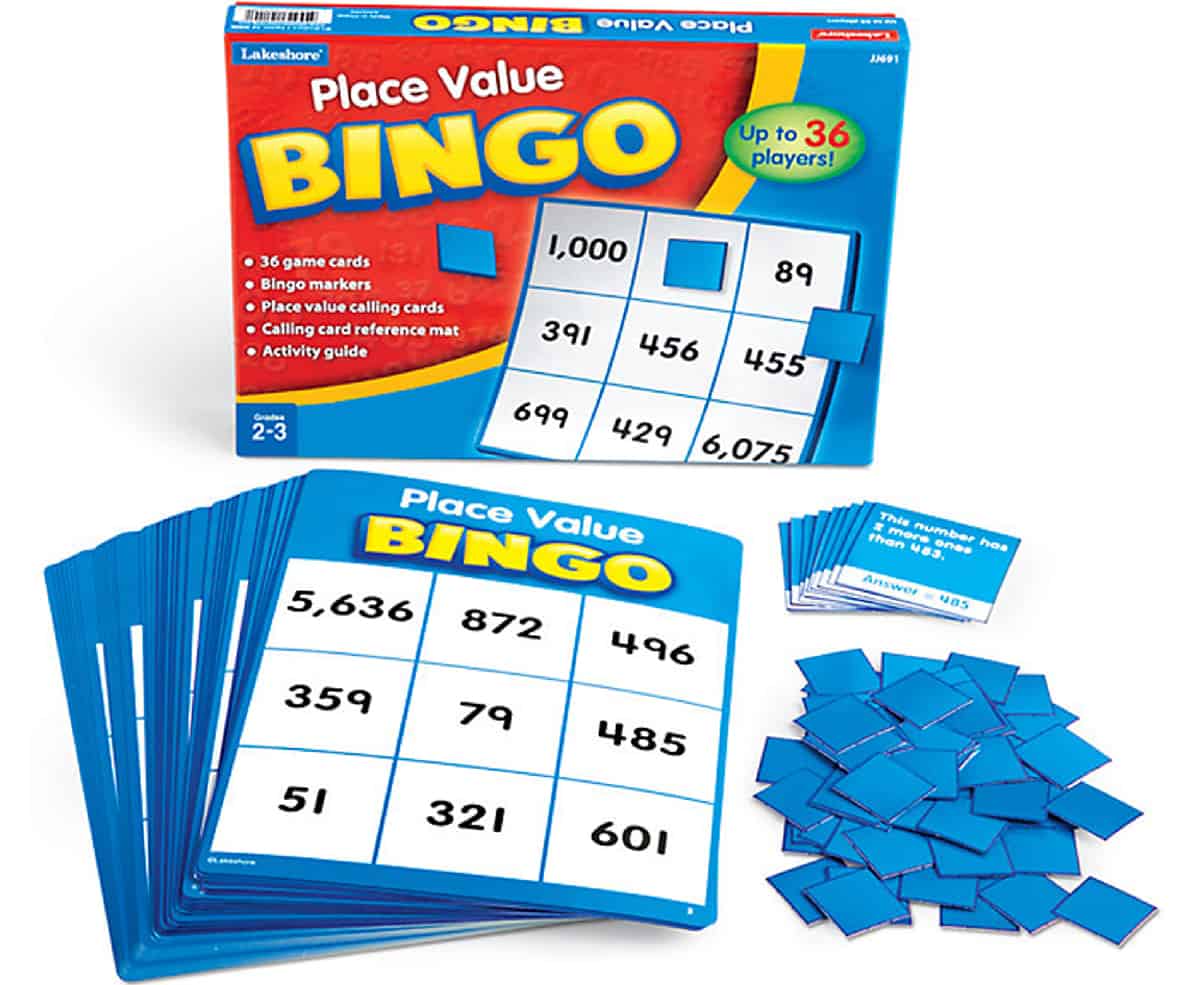
Players: Up to 36 players | Ages: 7-8 | For Schools | Price: $$
In Place Value Bingo by Lakeshore , students solve place value problems to fill in their game cards.
, students solve place value problems to fill in their game cards.
The game contains 36 game cards, 50 calling cards, a reference mat, and over 320 marker chips.
It reinforces the understanding of place value (ones, tens, hundreds and thousands) and makes practice arithmetic operations on numbers up to 1000.
The teacher reads out place value problems from the fifty calling cards provided (example: “This number has 2 more ones than 483”). Students then solve the problem and mark off the answer if it’s present on their card.
The answer is written below the place value problem to allow for self-correction, which is great.
Place Value Bingo (Trend Enterprises Inc.)
★★★☆☆

Players: 3-36| Ages: 7+ | For Schools | Price: $$
If you’re looking for an easier variation of place value bingo, this is an excellent option.
Trend’s Place Value Bingo is simpler than Lakeshore’s. Players simply need to identify hundreds, tens, and ones and understand the place value system (no operations are performed).
is simpler than Lakeshore’s. Players simply need to identify hundreds, tens, and ones and understand the place value system (no operations are performed).
It includes 36 different playing cards, Caller’s cards & mat, Bingo chips and an answer guide.
I like the original way to play bingo. You can win in five different ways (top-row, middle, bottom-row, corner, win-any-way) instead of the “whole-card” way, and you have to stay focused on the place value that the teacher calls out and not only on the whole number.
Beat the Penguin Bingo Place Value Game (Learn Can Be Fun)
★★★★☆
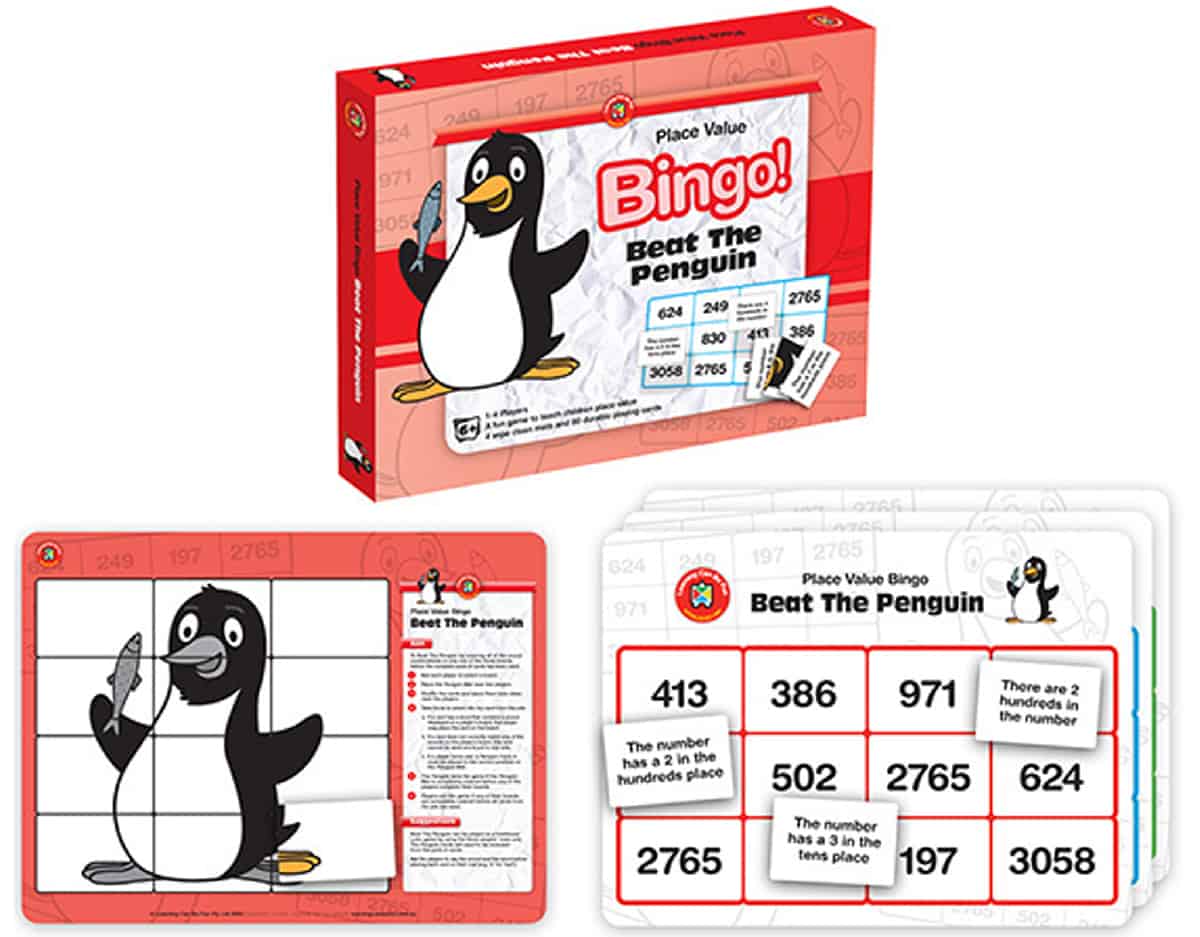
Players: 1-3| Ages: 7-9 | For Classrooms & Families | Price: AUS$$$
Penguin wants to test players’ knowledge though Bingo. This game includes 4 wipe-clean boards and 81 laminated cards.
In Beat the Penguin , players guess place value though different questions cards called out. It helps understand place value up to 1000 but not operations.
, players guess place value though different questions cards called out. It helps understand place value up to 1000 but not operations.
Cards are drawn out. If a player finds the right match on their board, the card is placed on that answer. However, if a penguin card is turned over, it is placed in the correct position on the penguin board. If the penguin board fills up first, then the penguin has won the game!
I like that it is a collaborative game – very interesting for a Bingo. All players win or lose together, which fosters teamwork.
Place Value Domino Games
Place Value Dominoes (Didax)
★★★☆☆
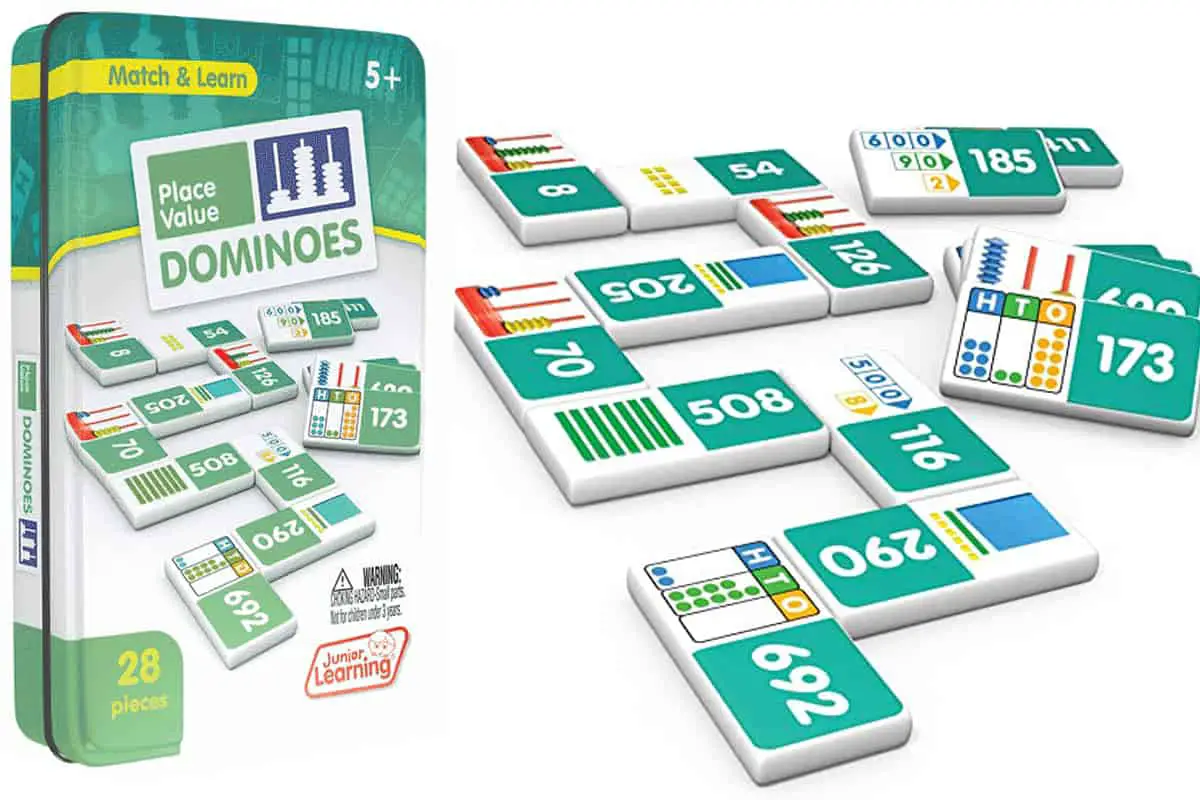
Players: 1-4 | Ages: 7+ | For Classrooms & Families | Price: $$
Place Value Dominoes by Didax uses 28 thick plastic dominoes featuring several representations of place value (digits, beads, base-ten blocks and place value cards..) with numbers up to 1000.
uses 28 thick plastic dominoes featuring several representations of place value (digits, beads, base-ten blocks and place value cards..) with numbers up to 1000.
Rules are basic domino rules.
I like that there are many relevant different place value representations.
Place Value Dominoes (Remedia Publications)
★★★☆☆
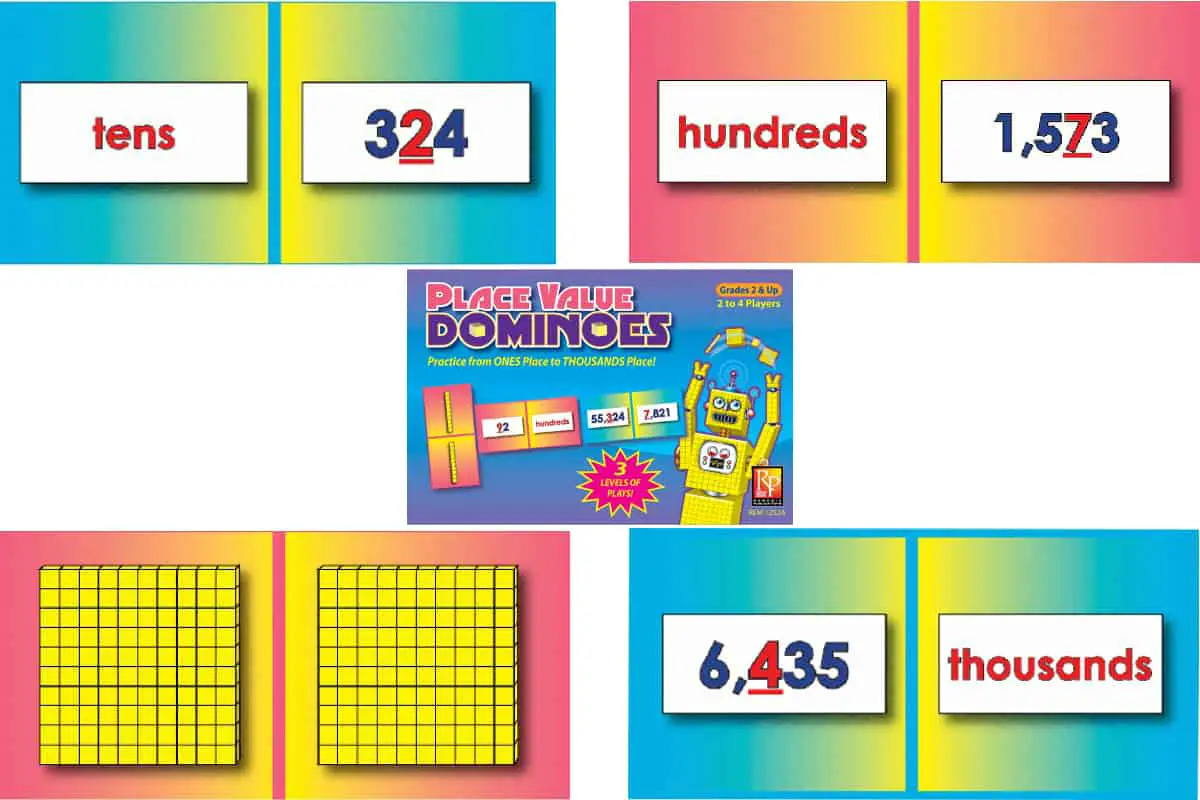
Players: 2-4 | Ages: 7+ | For Schools | Price: $$
In Place Value Dominoes by Remedia , players identify place value though 3 different representations such (cubes/rods/flats, numbers, and place value written in letters), with 48 dominoes up to 100,000.
, players identify place value though 3 different representations such (cubes/rods/flats, numbers, and place value written in letters), with 48 dominoes up to 100,000.
It is similar to Didax’s domino game, with more dominoes and a different domino matching system. Numbers do not have to completely match, just one place value at a time. This can sometimes be confusing for some children but does focus the attention on the pace value system.
Other Games
Feed Me – Place Value Chips (Really Good Stuff)
★★★☆☆
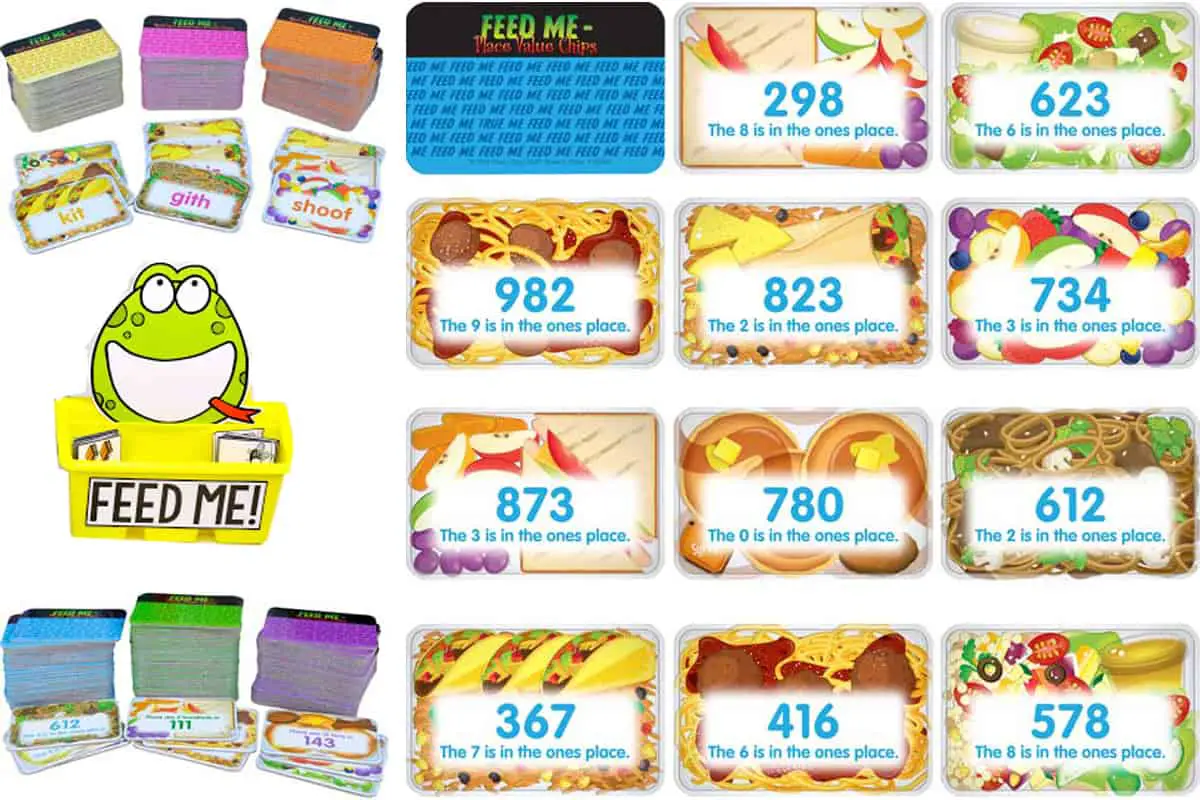
Age: 6-8 | Grades 1-2 | Number of Players: 1+
In Feed Me , players are asked to self-check their understanding of place value.
, players are asked to self-check their understanding of place value.
Feed Me contains 100 color-coded place value statement cards (the color corresponds to the problem dealing with ones, tens or hundreds), for example “788 – The 7 is in the hundreds place”.
Players sort the cards: one pile for true statements and the other for false ones.
Card are illustrated with foods.
An additional Feed Me Basket Set enables to sort the cards to monster baskets. Correct answers go to the green monster, while incorrect answers go to the red monster.
enables to sort the cards to monster baskets. Correct answers go to the green monster, while incorrect answers go to the red monster.
Feed Me is not really a game but a fun activity for young players though.
Why Is Learning Place Value Important?
What is important to make Children understand is that 10 digits (0 to 9) are enough to build any number, but the value of these digits depends on the place where they are in the number.
Place value is not natural for western children. English (and other European languages such as French) do not use a straightforward base ten based numbering system. For example, twenty is called “two ten” in Chinese or Japanese, and fifty “five ten”. Asian children tend to understand place value instinctively as their language uses the system, while western children tend to struggle at first (and sometimes take years to really understand it).
Even if, as an adult, it seems to be obvious, Place Value is a great human achievement. Understanding place value helps build a strong foundation for arithmetic and algebra during primary school.
But it has also greatly helped to make the modern world possible. In Europe, the base ten system (Arabic numbers) was introduced in the middle ages but started to be used only during the renaissance, as businessmen needed to do their accounting and needed a simple calculus system. Later, scientists used the system and science benefited from drastically simpler calculus methods (imagine how calculus was made by antique Roman mathematicians when they used the roman numbering system instead).
Edudingo.com is a participant in the Amazon Services LLC Associates Program, an affiliate advertising program designed to provide a means for sites to earn advertising fees by advertising and linking to Amazon.com. We also participate in other affiliate programs which compensate us for referring traffic.

